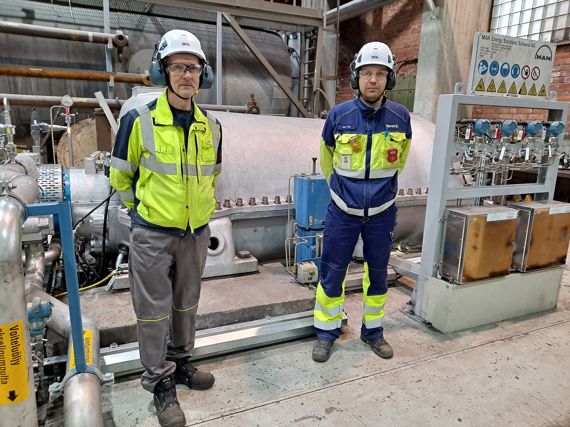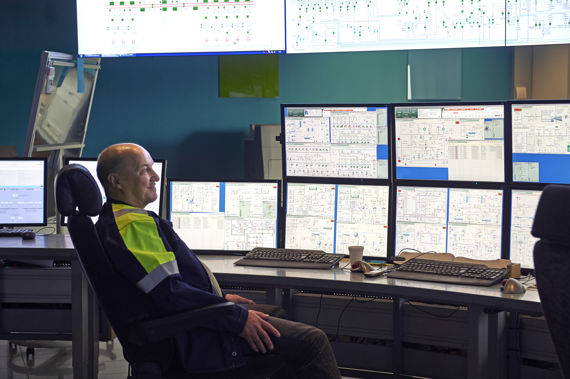SSAB: A unified automation concept strengthens blast furnace and power plant operations
Aug 6, 2021
SSAB’s Raahe steel mill manufactures standard, premium and specialty steel. A comprehensive Valmet automation system provides greater safety and reliability for the blast furnace motor fan. Founded in 1960, the Raahe steel mill has a long tradition. Today, it is part of the international SSAB steel group, whose blast-furnace production is one of the world’s most carbon efficient.
Upgraded automation for today
The steel mill uses a comprehensive Valmet DNA automation system. The integrated automation and unified user interface facilitate process control and monitoring.
In February 2020, work began on an upgrade to increase the power of the blast furnace air blower (motor blower MP01) and modernize the automation. The project was completed the following February.
The lead designer of the automation concept was Tapani Seppälä from SSAB’s investment service department. He participated in defining the applications together with the automation and fan suppliers.
Tapani says: “The goal while replacing the motor fan MP01 was to upgrade the earlier automation system supplied by Valmet which was implemented with now outdated technology, such as individual programmable logic unit (PLU) and analog controller unit (ACU) control board cards. At the same time, the fan motor power was increased from 7 MW to 11 MW.”

Completely unified control concept brings advantages
Blast furnaces in steel mills play an important role in the ironmaking process. To intensify the combustion, oxygen-rich air is blown into the blast furnace with motor fans. The blast furnace air blowers and their auxiliary systems produce the combustion air needed by the blast furnace. The fans are physically located at and operated from Raahen Voima Oy’s power plant.
While modernizing the motor fan control system, its safety logic was upgraded with a HIMA system. Previously, this security was implemented with PLU cards. HIMA is connected with a Safe Ethernet to the Valmet DNA automation system. Valmet’s DNA Machine Monitoring was added to monitor the machine bearing vibration levels, the shaft position and the thrust bearing wear.
At the same time, the cyber operating environment definition was carefully studied by Valmet together with the customer.
Tapani Seppälä is satisfied with the resulting overall automation system. “The automation for the MP01 blast furnace air blower has been integrated with the power plant’s main automation system. Now, we have one unified automation concept that combines the various systems – control, protection and continuous condition monitoring.”
Valmet’s overall concept is also applicable to other fans and processes at the steel mill, allowing it to gain greater benefits from the best practices being applied.

Image source: SSAB
No black box, just clear automation
A unified equipment base offers benefits to maintenance staff as well as operators. Tapani Seppälä mentions the programmable logic controller (PLC) as a point for comparison.
“Today, our user interface, reporting and diagnostics are all integrated within Valmet’s system. When alarm and lock timestamps all use the same clock, the clarity of when disturbances occur is unmistakable,” Tapani Seppälä confirms.
According to Tapani, one of the biggest benefits is that the application is based on an open code source – not a black box that only the supplier can access. “The design documentation is done with AutoCAD. In addition, we have remote access and lifecycle services for the existing environment. Having local system and application support will continue to bring us significant advantages – and this may be the most important benefit for us,” Tapani says.
“Long-term cooperation with Valmet’s product development and application experts in both the hardware and application environment has built trust and credibility when developing new applications for demanding process areas. This seems to be the best way forward, also in the future,” Tapani sums up.

Image source: SSAB
Successful project collaboration
Valmet’s project manager Eero Kitinoja and application expert Miika Tilus emphasize the good collaboration with the customer. They agree with Tapani that a unified delivery package serves the customer best. Local support, quick availability of critical parts and expert service also make the cooperation economically viable.
The coronavirus pandemic created limitations during the project. The factory acceptance test (FAT) was carried out virtually for the fan section controls and protection. Testing was postponed a few times, and the number of participants in the same space was restricted. With the use of digital tools, however, the project succeeded nicely.
“Our customer had a strong belief in the design and implementation of the project. Collaboration was exceptionally smooth with both the customer and the fan supplier. That is an absolute prerequisite for the success of such a demanding project,” Miika says.